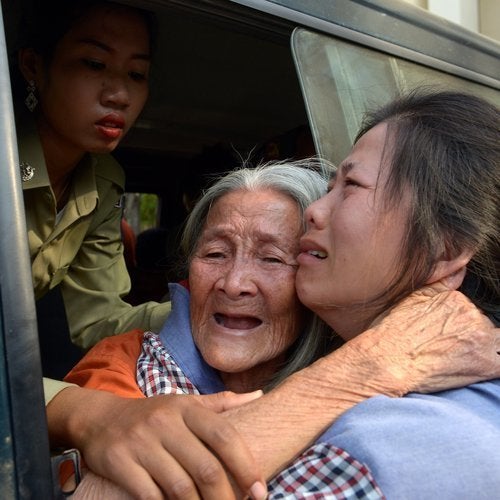
After years of delay, the World Bank is taking action to address sweeping failures in its oversight of development projects that force people from their land or harm their livelihoods.
The changes are aimed at fixing a decades-long problem at the planet’s preeminent development lender: the World Bank has strong “social safeguards” for protecting people in the path of development, but it often fails to make sure that governments that get the bank’s money follow these rules.
The bank has completed a reorganization that gives the specialists who enforce social safeguards independent budgets and supervisors, to give them autonomy from the managers of the projects they oversee. The bank said that it is also hiring 11 new social safeguards specialists, reviewing its lending portfolio to identify projects in need of additional safeguards support, and requiring that all safeguards staff attend a “Resettlement Boot Camp.”
In addition, the bank said that it has increased funding for safeguards operations by about 15 percent, although it did not provide specific budget figures.
“We recognize that our efforts have not always been sufficient, and we are continuing to engage with borrowers to make sure that people displaced physically or economically are compensated and assisted,” the World Bank said in a statement. “We can, and must, do better.”
From 2004 to 2013, development projects financed by the bank such as dams, roads and power plants physically or economically displaced an estimated 3.4 million people, the International Consortium of Investigative Journalists, The Huffington Post and other media partners reported in April. The bank often failed to follow its rules for protecting these communities and in some cases funded governments and companies accused of human rights abuses, the reporting team’s “Evicted & Abandoned” investigation revealed.
In March 2015 – five days after the reporting team sent detailed questions informing the bank it had found “systemic gaps” in its protections for people displaced by its projects – World Bank Group President Jim Yong Kim issued a statement admitting “major problems” with the bank’s resettlement practices and announcing a reform plan to fix them.
Kim’s statement also disclosed internal reviews by the bank, one of which was completed in 2012, which warned of serious flaws in the bank’s resettlement practices. The bank had kept these reports secret for years, and Kim’s comments represented the bank’s first public admission of broad resettlement failures.
“The promise that we are making is that as these problems surface we will let you know about them, and we will tell you specifically how we are going to move to correct those problems,” Kim told the German public broadcaster NDR, a partner in ICIJ’s investigation, in a March press conference in Berlin.
Since March, the reporting team has regularly inquired about the details and progress of the bank’s reform plan. The latest update, announced on a fact sheet posted on the bank’s website on Dec. 16, came in response to questions sent by ICIJ, The Huffington Post, NDR, Süddeutsche Zeitung and Fusion.
The bank established an independent and substantially increased budget for safeguards operations in the current fiscal year that started on July 1, 2015, according to Anis Dani, a former lead evaluator at the bank’s internal Independent Evaluation Group. Dani, who still keeps informed about the bank’s work on safeguards issues since his retirement from the bank, said the new system will allow safeguards experts to decide when closer supervision is necessary.
“What they had in the action plan was just an idea and now they actually have the money for it,” Dani said. “Which means they are taking safeguards much more seriously than in the past.”
The bank said it has also implemented two oversight tools announced in 2014, a Systematic Risk Rating Tool and a Tracking Social Performance database, which are now being used for all new projects.
The World Bank’s rules require that governments that receive the bank’s loans restore the livelihoods and living conditions of communities negatively affected by their projects to an equal or better standard than before the project was approved, and to resettle people who lose their homes.
ICIJ’s investigation found that the bank often failed to properly review projects ahead of time to make sure that people living in the path of its projects were protected, and often did not keep track of what happened to displaced communities after projects were approved. In many cases, governments and companies funded by the bank did not adequately resettle or compensate people who were displaced. In some instances, the bank’s borrowers used threats and violence to push people out of their homes.
Human rights groups that have criticized the bank’s record on resettlement said the latest reforms had positive elements, but that bank still needed to fulfill its obligations to communities affected by previous resettlement failures.
“There is no acknowledgement of the harm already caused and no plan to do anything about it,” said Kate Geary, the land rights policy lead at Oxfam.
In a Dec. 16 letter to Geary and other human rights advocates, Maninder Gill, a World Bank senior manager who is one of the leaders of the team carrying out the bank’s action plan, recognized that the plan “does not articulate how we provide redress to the individuals and communities that have been displaced by World Bank projects.”
Gill wrote that the bank was reviewing the issue and would share its results in future meetings.
Jessica Evans, a senior researcher and advocate at Human Rights Watch, said the bank’s recent actions focused strongly on its capacity to assess social and environmental risk.
“The real emphasis here is on risk analysis and mitigation,” Evans said. “And that is important, but the biggest challenge is what really happens on the ground.”
She said that the added scrutiny would improve the bank’s understanding of the risks, but that it would still face critical decisions of whether to approve projects that threaten local communities, or to compel reluctant borrowers to fully comply with its safeguards.
“What I would really like to see is what practices the bank is going to change,” Evans said.
Dani, the former internal evaluator, said that better monitoring would be crucial to ensuring that reforms were having an effect in the real world. Since safeguards operations are now centralized in independent units of the bank, he said, the bank could provide annual updates with aggregate statistics tracking the number of people displaced by its projects and the outcomes of their compensation and resettlement.
“It would be nice to hear from them how this is leading to better results,” Dani said.
